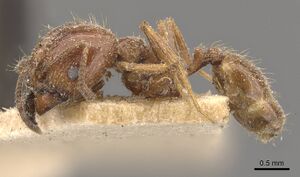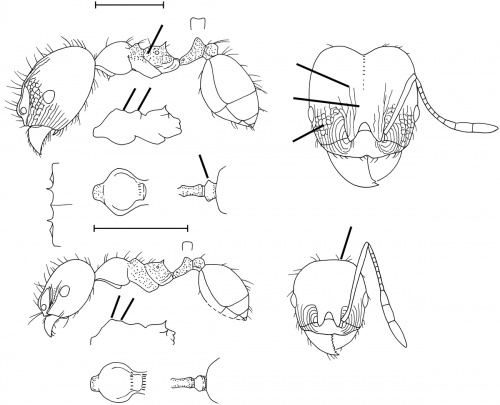Pheidole nitidula
| Pheidole nitidula | |
|---|---|

| |
| Scientific classification | |
| Kingdom: | Animalia |
| Phylum: | Arthropoda |
| Class: | Insecta |
| Order: | Hymenoptera |
| Family: | Formicidae |
| Subfamily: | Myrmicinae |
| Tribe: | Attini |
| Genus: | Pheidole |
| Species group: | fallax |
| Species: | P. nitidula |
| Binomial name | |
| Pheidole nitidula Emery, 1888 | |
| Synonyms | |
| |
Little is known about the biology of Pheidole nitidula.
Identification
See the description in the nomenclature section.
Keys including this Species
Distribution
I have verified material from Buenos Aires, Córdova, Misiones, and Salta in Argentina, and Rio Grande do Sul in Brazil. Kempf (1972b) also reports it from Rio de Janeiro. (Wilson 2003)
Latitudinal Distribution Pattern
Latitudinal Range: -14.798611° to -37.533333°.
| North Temperate |
North Subtropical |
Tropical | South Subtropical |
South Temperate |
- Source: AntMaps
Distribution based on Regional Taxon Lists
Neotropical Region: Argentina (type locality), Brazil.
Distribution based on AntMaps
Distribution based on AntWeb specimens
Check data from AntWeb
Countries Occupied
| Number of countries occupied by this species based on AntWiki Regional Taxon Lists. In general, fewer countries occupied indicates a narrower range, while more countries indicates a more widespread species. |

|
Estimated Abundance
| Relative abundance based on number of AntMaps records per species (this species within the purple bar). Fewer records (to the left) indicates a less abundant/encountered species while more records (to the right) indicates more abundant/encountered species. |

|
Biology
Association with Other Organisms
 Explore: Show all Associate data or Search these data. See also a list of all data tables or learn how data is managed.
Explore: Show all Associate data or Search these data. See also a list of all data tables or learn how data is managed.
- This species is a host for the ant Pheidole acutidens (a workerless inquiline) in Brazil (Ferreira et al., 2016).
- This species is a host for the eucharitid wasp Orasema argentina (a parasite) (Universal Chalcidoidea Database) (primary host).
- This species is a host for the eucharitid wasp Orasema worcesteri (a parasite) (Gemignani, 1933; Heraty et al., 1993; Baker et al., 2019; Universal Chalcidoidea Database) (primary host).
- This species is a host for the eucharitid wasp Orasema worcesteri (a parasitoid) (Quevillon, 2018) (encounter mode independent; direct transmission; transmission outside nest).
Castes
Worker
Minor
Images from AntWeb
   
| |
| Syntype of Pheidole perversa richteri. Worker. Specimen code casent0908151. Photographer Z. Lieberman, uploaded by California Academy of Sciences. | Owned by MHNG, Geneva, Switzerland. |
   
| |
| Paralectotype of Pheidole triconstricta nitidula. Worker. Specimen code casent0904328. Photographer Z. Lieberman, uploaded by California Academy of Sciences. | Owned by MSNG, Genoa, Italy. |
   
| |
| Syntype of Pheidole strobeli. Worker. Specimen code casent0904389. Photographer Z. Lieberman, uploaded by California Academy of Sciences. | Owned by MSNG, Genoa, Italy. |
Major
Images from AntWeb
   
| |
| Syntype of Pheidole perversa richteri. Worker (major/soldier). Specimen code casent0908150. Photographer Z. Lieberman, uploaded by California Academy of Sciences. | Owned by MHNG, Geneva, Switzerland. |
   
| |
| Syntype of Pheidole strobeli. Worker (major/soldier). Specimen code casent0904388. Photographer Z. Lieberman, uploaded by California Academy of Sciences. | Owned by MSNG, Genoa, Italy. |
   
| |
| Lectotype of Pheidole perversa. Worker (major/soldier). Specimen code casent0908152. Photographer Will Ericson, uploaded by California Academy of Sciences. | Owned by MHNG, Geneva, Switzerland. |
Nomenclature
The following information is derived from Barry Bolton's Online Catalogue of the Ants of the World.
- nitidula. Pheidole triconstricta var. nitidula Emery, 1888e: 693 (s.w.) ARGENTINA.
- Santschi, 1929d: 281 (q.m.).
- Raised to species: Emery, 1906c: 154.
- Senior synonym of silvicola and material of the unavailable names labrata, vicina referred here: Wilson, 2003: 328.
- silvicola. Pheidole strobeli subsp. silvicola Borgmeier, 1927b: 61 (s.w.) BRAZIL.
- [Also described as new by Borgmeier, 1928a: 39.]
- Subspecies of nitidula: Santschi, 1929d: 283.
- Junior synonym of nitidula: Wilson, 2003: 328;
Type Material
ARGENTINA: La Plata, Buenos Aires, col. C. Spegazzini. Museo Civico di Storia Naturale, Genoa - as reported in Wilson (2003) Unless otherwise noted the text for the remainder of this section is reported from the publication that includes the original description.
Description
From Wilson (2003): A member of the fallax group, similar to Pheidole bergi, Pheidole cordiceps, Pheidole dione, Pheidole eidmanni and Pheidole pampana of southern South America, differing as follows.
Major: pilosity sparse; rugoreticulum on each side of head extends between eye and antennal fossa and anteriorly almost to border of head; vertex smooth; carinulae originating on frontal lobes not quite reaching midway between level of eyes and level of occiput; pronotal dorsum in dorsal-oblique view weakly bilobous; metanotal convexity in side view symmetrical; carinulae absent from sides of propodeum; postpetiole from above symmetrical.
Minor: pilosity sparse; pronotum in dorsal-oblique view feebly bilobate; occiput in frontal view feebly convex, nearly flat, lacking nuchal collar.
MEASUREMENTS (mm) Lectotype major: HW 1.30, HL 1.32, SL 0.84, EL 0.22, PW 0.66. Paralectotype minor: HW 0.68, HL 0.74, SL 0.82, EL 0.18, PW 0.44.
COLOR Major: concolorous reddish brown.
Minor: concolorous plain medium brown.
Figure. Upper: lectotype, major. Lower: paralectotype, minor. Scale bars = 1 mm.
Etymology
L nitidula, little shining one. (Wilson 2003)
References
- Wilson, E. O. 2003. Pheidole in the New World: A dominant, hyperdiverse ant genus. Harvard University Press, Cambridge, MA. (page 328, fig. major, minor described, Senior synonym of strobeli, perversa, richteri, misera, silvicola, daguerrei)
- Baker, A.J., Heraty, J.M., Mottern, J., Hang, J.Z., Hines, H.M., Lemmon, A.R., Lemmon, E.M. 2019. Inverse dispersal patterns in a group of ant parasitoids (Hymenoptera: Eucharitidae: Oraseminae) and their ant hosts. Systematic Entomology 45: 1–19 (doi:10.1111/syen.12371).
- Casadei-Ferreira, A., Economo, E.P., Feitosa, R.M. 2020. Additions to the taxonomy of Pheidole (Hymenoptera: Formicidae) from the southern grasslands of Brazil. Revista Brasileira de Entomologia 64(4):e20200068 (doi:10.1590/1806-9665-RBENT-2020-0068).
- de la Mora, A., Sankovitz, M., Purcell, J. 2020. Ants (Hymenoptera: Formicidae) as host and intruder: recent advances and future directions in the study of exploitative strategies. Myrmecological News 30: 53-71 (doi:10.25849/MYRMECOL.NEWS_030:053).
- Emery, C. 1888e. Alcune formiche della Repubblica Argentina raccolte dal Dott. C. Spegazzini. Ann. Mus. Civ. Stor. Nat. 26[=(2)(6): 690-694 (page 693, soldier, worker described)
- Emery, C. 1906c [1905]. Studi sulle formiche della fauna neotropica. XXVI. Bull. Soc. Entomol. Ital. 37: 107-194 (page 154, raised to species)
- Ferreira, A., Martins, M., Feitosa, R. 2016. Rediscovery of the morphologically remarkable social parasite Pheidole acutidens (Bruch), with the first records for Brazil. Sociobiology 63, 1069. (doi:10.13102/sociobiology.v63i4.1263).
- Santschi, F. 1929d. Nouvelles fourmis de la République Argentine et du Brésil. An. Soc. Cient. Argent. 107: 273-316 (page 281, queen, male described)
References based on Global Ant Biodiversity Informatics
- Brandao, C.R.F. 1991. Adendos ao catalogo abreviado das formigas da regiao neotropical (Hymenoptera: Formicidae). Rev. Bras. Entomol. 35: 319-412.
- Bruch C. 1914. Catálogo sistemático de los formícidos argentinos. Revista del Museo de La Plata 19: 211-234.
- Cuezzo, F. 1998. Formicidae. Chapter 42 in Morrone J.J., and S. Coscaron (dirs) Biodiversidad de artropodos argentinos: una perspectiva biotaxonomica Ediciones Sur, La Plata. Pages 452-462.
- Emery C. 1906. Studi sulle formiche della fauna neotropica. XXVI. Bullettino della Società Entomologica Italiana 37: 107-194.
- Kempf, W.W. 1972. Catalago abreviado das formigas da regiao Neotropical (Hym. Formicidae) Studia Entomologica 15(1-4).
- Kusnezov N. 1952. El género Pheidole en la Argentina (Hymenoptera, Formicidae). Acta Zoologica Lilloana 12: 5-88.
- Kusnezov N. 1978. Hormigas argentinas: clave para su identificación. Miscelánea. Instituto Miguel Lillo 61:1-147 + 28 pl.
- Santschi F. 1929. Nouvelles fourmis de la République Argentine et du Brésil. Anales de la Sociedad Cientifica Argentina. 107: 273-316.
- Vittar, F. 2008. Hormigas (Hymenoptera: Formicidae) de la Mesopotamia Argentina. INSUGEO Miscelania 17(2):447-466
- Vittar, F., and F. Cuezzo. "Hormigas (Hymenoptera: Formicidae) de la provincia de Santa Fe, Argentina." Revista de la Sociedad Entomológica Argentina (versión On-line ISSN 1851-7471) 67, no. 1-2 (2008).
- Zolessi L. C. de, Y. P. Abenante, and M. E. de Philippi. 1988. Lista sistematica de las especies de Formicidos del Uruguay. Comun. Zool. Mus. Hist. Nat. Montev. 11: 1-9.
- Zolessi L. C. de; Y. P. de Abenante, and M. E. Philippi. 1989. Catálogo sistemático de las especies de Formícidos del Uruguay (Hymenoptera: Formicidae). Montevideo: ORCYT Unesco, 40 + ix pp.
- de Zolessi, L.C., Y.P. de Abenante and M.E. Philippi. 1987. Lista sistemática de las especies de formícidos del Uruguay. Comunicaciones Zoologicas del Museo de Historia Natural de Montevideo 11(165):1-9
- de Zolessi, L.C., Y.P. de Abenante and M.E. Phillipi. 1989. Catalago Systematico de las Especies de Formicidos del Uruguay (Hymenoptera: Formicidae). Oficina Regional de Ciencia y Technologia de la Unesco para America Latina y el Caribe- ORCYT. Montevideo, Uruguay
- Pages using DynamicPageList3 parser function
- Tropical
- South subtropical
- South temperate
- Ant Associate
- Host of Pheidole acutidens
- Eucharitid wasp Associate
- Host of Orasema argentina
- Host of Orasema worcesteri
- Species
- Extant species
- Formicidae
- Myrmicinae
- Attini
- Pheidole
- Pheidole nitidula
- Myrmicinae species
- Attini species
- Pheidole species
- Ssr



